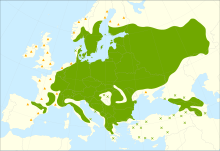Norway Maple
| Norway maple | |
|---|---|
 |
|
| Norway maple leaves | |
| Scientific classification | |
| Kingdom: | Plantae |
| (unranked): | Angiosperms |
| (unranked): | Eudicots |
| (unranked): | Rosids |
| Order: | Sapindales |
| Family: | Sapindaceae |
| Genus: | Acer |
| Species: | A. platanoides |
| Binomial name | |
|
Acer platanoides L. |
|
 |
|
| Distribution map | |
| Synonyms | |
|
List
|
|
Acer platanoides (Norway maple) is a species of maple native to eastern and central Europe and western Asia, from France east to Russia, north to southern Scandinavia and southeast to northern Iran. It is a member of the soapberry and lychee family.
Acer platanoides is a deciduous tree, growing to 20–30 m (65–100 ft) tall with a trunk up to 1.5 m (5 ft) in diameter, and a broad, rounded crown. The bark is grey-brown and shallowly grooved. Unlike many other maples, mature trees do not tend to develop a shaggy bark. The shoots are green at first, soon becoming pale brown. The winter buds are shiny red-brown.
The leaves are opposite, palmately lobed with five lobes, 7–14 cm (2 3⁄4–5 1⁄2 in) long and 8–20 cm or 3 1⁄4–7 3⁄4 in (rarely 25 cm or 9 3⁄4 in) across; the lobes each bear one to three side teeth, and an otherwise smooth margin. The leaf petiole is 8–20 cm (3 1⁄4–7 3⁄4 in) long, and secretes a milky juice when broken. The autumn colour is usually yellow, occasionally orange-red.
The flowers are in corymbs of 15–30 together, yellow to yellow-green with five sepals and five petals 3–4 mm (0–1⁄4 in) long; flowering occurs in early spring before the new leaves emerge. The fruit is a double samara with two winged seeds. the seeds are disc-shaped, strongly flattened, 10–15 mm (3⁄8–5⁄8 in) across and 3 mm (1⁄8 in) thick. The wings are 3–5 cm (1 1⁄4–2 in) long, widely spread, approaching a 180° angle. It typically produces a large quantity of viable seeds.
...
Wikipedia
